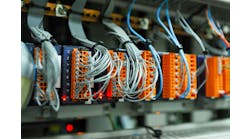Here is the second part of a point blank decisive comprehensive list of what we really need to know in a detailed attempt to reduce the disparity between theory and practice. Please read, think and take to heart the opportunities to increase the performance and recognized value of our profession. The list is necessarily concise in detail.
If you want more information on these opportunities, please join the ISA Mentor Program and ask the questions whose answers can be shared via Mentor Q&A Posts.
You can also get a comprehensive resource focused on what you really need to know for a successful automaton project including nearly a thousand best practices in the 98% new 2019 Process/Industrial Instruments and Controls Handbook Sixth Edition capturing the expertise of 50 leaders in industry.
- Ratio control instead of feedforward control. Most of the literature focuses on feedforward control. This is like flying blind for the operator. In most cases there is a flow measurement and the primary process loop dead time is large enough for there to be a cascade control using a secondary flow loop. A ratio controller is then setup whose input is the flow signal that would have been the feedforward signal. This could be a disturbance or wild flow or a feed flow in the applications involving most vessels (e.g., crystallizers, evaporators, neutralizers, reactors …) and columns. To provide a shortcut in categorization, I simply call it the “leader flow”. The secondary loop then is the “follower” flow whose setpoint is the “leader” flow multiplied by the ratio controller setpoint. A bias is applied to the Ratio controller output similar to what is done by a feedforward summer that is corrected by the primary loop. The operator can change the ratio setpoint and see the actual ratio after correction. Improvements can be made to the ratio setpoint based on recognizable persistent differences between set and the actual ratio. Many vessels and most columns are started up on ratio control until normal operating conditions are reached. When primary loops use an analyzer, ratio correction may be suspended when the analyzer misbehaves. If the flow measurement lacks sufficient rangeability, a flow can be computed from the installed flow characteristic and substituted for the flow measurement at low flows. A notable exception is avoidance of ratio control for steam header pressures since the dead time is too short for cascade control consequently necessitating feedforward control.
- Adaptation of feedforward gain and ratio control setpoint. A simple adaptive controller similar to a valve position controller (VPC) for optimization can be used. The adaptive controller setpoint is zero correction, its process variable is the current correction and its output is the feedforward gain or ratio setpoint. Like a VPC, the traditional approach would be a slow integral-only controller where the integral action is more than 10 times slower than in the primary loop controller. However, the opportunity for directional move suppression described next month can provide more flexibility and opportunity to deal with undesirable conditions.
- PID Form and Structure used in Industry. The literature often shows the “Independent” Form that computes the contribution of the P, I and D modes in parallel with the proportional gain not affecting the I and D modes. The name “Independent” is appropriate not only because the contribution of the modes are independent from each other but also because this Form is independent of what is normally used in today’s distributed control systems (DCSs). Often the tuning parameters for I and D are an integral and derivative gain, respectively rather than a time. The “Series” or “Real” Form necessarily used in pneumatic controllers was carried over to electronic controllers and is offered as an option in DCSs. The “Series” Form causes an interaction in the time domain that can be confusing but prevents the D mode contribution from exceeding the I mode contribution. Consequently, tuning where the D mode setting is larger the I mode setting do not cause oscillations. If these are settings are carried over to the “Ideal” Form more extensively today, the user is surprised by unsuspected fast oscillations. The different units for tuning settings also cause havoc. Some proportional modes still use proportional band in percent and integral settings could be repeats per minute repeats per second instead of minutes or seconds. Then you have the possibility of an integral gain and derivative gain in an Independent Form. Also, the names given by suppliers for Forms are not consistent. There are also 8 structures offering options to turn off the P and I mode or use setpoint weight factors for the P and D modes. The D mode is simply turned off by a zero setting (zero rate time or derivative gain). I am starting an ISA Standards Committee for PID algorithms and performance to address these issues and many more. For more on PID Forms see the ISA Mentor Q&A “How do you convert tuning settings of an independent PID?”
- Sources of Deadband, Resolution, Sensitivity, and Velocity Limit. Deadband can originate from backlash in linkages or connections, deadband in split range configuration, and deadband in Variable Frequency Drive (VFD) setup. Resolution limitation can originate from stiction and analog to digital conversion or computation. Sensitivity limitations can originate from actuators, positioners, or sensors. Velocity Limits can originate from valve slewing rate set by positioner or booster relay capacity and actuator volume and from speed rate limits in VFD setup.
- Oscillations from Deadband, Resolution, Sensitivity, and Velocity Limit. Deadband can cause a limit cycle if there are two or more integrators in the process or control system including the positioner.Thus, a positioner with integral action will create a limit cycle in any loop with integral action in the controller. Positioners should have high gain proportional action and possibly some form of derivative action. Resolution can cause a limit cycle if there are two or more integrators in the process or control system including the positioner. Positioners with poor sensitivity have been observed to create essentially a limit cycle. A slow velocity limit causes oscillations that can be quite underdamped.
- Noise, resonance and attenuation. The best thing to do is eliminate the source of oscillations often due to the control system as detailed in the Control Talk Blog “The Most Disturbing Disturbances are Self-Inflicted”. Oscillation periods faster than the loop dead time is essentially noise. There is nothing the loop can do so the best thing is to ignore it. If the oscillation period is between one and ten dead times cause resonance. The controller tuning needs to be less aggressive to reduce amplification. If the oscillation period is more than 10 times the dead time, the controller tuning needs to be more aggressive to provide attenuation.
- Control Loops Transfer Variability. We would like to think a control loop makes variability completely disappear. What it does is transfer the variability from the controlled variable to the manipulated variable. For many level control loops, we want minimization of this transfer and give it the more positive terminology “maximization of absorption” of variability. This is done by less aggressive tuning that still prevents activation of alarms. The user must be careful that for near-integrating and true-integrating processes, the controller gain must not be decreased without increasing the integral time so that the product of the controller gain and integral time is greater than twice the inverse of the integrating process gain to prevent large slow rolling nearly underdamped oscillations with a period forty or more times the dead time.
- Overshoot of Controller Output. Some articles have advocated that the PID controller should be tuned so its output never overshoots the final resting value (FRV). While this may be beneficial for balanced self-regulating process particularly seen in refineries, it is flat out wrong and potentially unsafe for near-integrating, true integrating and runaway processes. In order to get to a new setpoint or recover from a disturbance, the controller output must overshoot the FRV. This generally requires that the integral mode not dominate the proportional and derivative mode contributions. Integrating process tuning rules are used.
- Hidden Factor in Temperature, Composition and pH Loops. The process gain in these loops for continuous and fed-batch operations is generally plotted versus a ratio of manipulated flow to feed flow. To provide a process gain with the proper units, you need to divide by the feed flow. Most people don’t realize the process gain is inversely proportional to feed flow. This is particularly a problem at low production rates resulting in a very large hidden factor. For much more on this see the Control Talk Blog “Hidden factor in Our Most Important Loops”.
- Variable Jacket Flow. If the flow to a vessel jacket is manipulated for temperature control, you have a double whammy. The low flow for a low cooling or heating demand causes an increase in the process gain per the hidden factor and an increase in the process dead time due to the larger transportation delay. The result is often a burst of oscillations from tuning that would be fine at normal operating conditions. A constant jacket flow should be maintained by recirculation and the manipulation of coolant or heating utility makeup flow (preferably steam flow to a steam injector) for high heat demands. The utility return flow is made equal to the makeup flow by a pressure controller on jacket output manipulating return flow.




